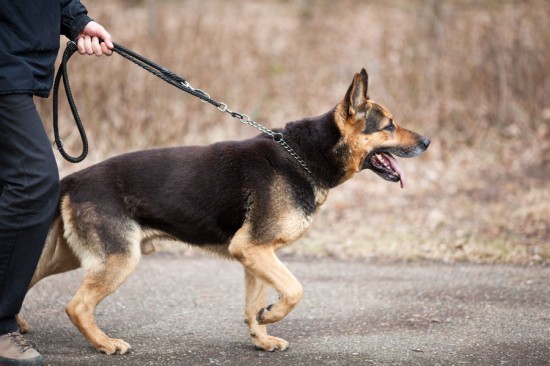
Head collars have become an increasingly popular dog training tool in the past few years. Two of the most well known brands of head collar on the market are the Gentle Leader and the Halti, but there are many other brands that incorporate the basic head collar concept.
Although a very helpful tool, a head collar should not be used as a replacement for effective dog training. A head collar is most effective when it is used in combination with strong and sensible dog training methods, such as reward training and other forms of positive reinforcement.
What type of head collar is best?
Many dog owners favor the Gentle Leader design, finding it easier to fit that the Halti. The Gentle Leader is also designed to fasten around the dog’s neck, which means that even if the dog is somehow able to wriggle out of the muzzle, it is still wearing a collar. This safety feature is very important, especially during training outside or in novel situations. The Halti, on the other hand, offers better control of the dog, and for this reason it is often favored when working with larger breeds. It is also useful when training an older dog who has developed any aggressive traits.
Training a dog with a head collar has a number of advantages over training with a traditional or training collar. Head collars are often easier to use for beginning dog trainers than are conventional training collars. Head collars are also quite effective at preventing dogs from pulling, or controlling and retraining dogs that tend to pull.
Head collars can also be quite effective at controlling dogs in difficult situations, such as controlling a dog that wants to be with other dogs. Most owners know of some situations in which their dogs are difficult to control, and head collars can be very useful in volatile situations.
Head collars are excellent for gaining control of dogs that are very strong, or for working with a dog in an area that contains a great many distractions. Head collars are great for when your dog is on an outing, or in an area where there will be other dogs and other distractions.
Are there any disadvantages in using head collars?
Well, yes, head collars do have some distinct disadvantages as well. Head collars tend to encourage a dog’s behavior to be dependent on the equipment being used at the time. Dogs quickly learn the difference between their regular collar and the head collar, and adjust their behavior accordingly, so you may find yourself having to use the head collar as a matter of course.
If a dog is not accustomed to wearing a head collar, there may be such a dislike of wearing it that your dog may paw at it, try to rub it off or pull excessively. If your dog exhibits this behavior, the best strategy is to keep your dog moving until it learns to accept the collar.
When you’re walking your dog with a head collar, you may find that many people think that a head collar is a muzzle, and react to the dog with some trepidation. While this is not necessarily a disadvantage of the head collar, many dog owners do find it troublesome.
So training with a head collar is much like training with a training collar or any other equipment. While the head collar can be an important and useful tool, it is important to fit it properly, use it appropriately, and to combine its use with solid training methods. The eventual goal of dog training with a head collar should be to have the dog behave as well with a regular collar as it does with the specialized head collar. And because some dogs behave differently when in the head collar and a regular collar, this goal may take considerable work to achieve!
Brigitte Smith runs two websites dedicated to dog training, dog care and dog health:
Grab your free special report here: Healthy Happy Dogs or here: Dog Training and Wellness
 Breeding From Your Dog - Caring For The Dam After The Birth
Breeding From You
Breeding From Your Dog - Caring For The Dam After The Birth
Breeding From You
 Mobile Grooming Services in Florida
Mobile Grooming Services in Florida
Grooming y
Mobile Grooming Services in Florida
Mobile Grooming Services in Florida
Grooming y
 The Bracco Italiano A Robust Breed With Few Health Issues
The Bracco Italia
The Bracco Italiano A Robust Breed With Few Health Issues
The Bracco Italia
 Walking The Dog (part 1)
Walking The Dog (
Walking The Dog (part 1)
Walking The Dog (
 Common Questions And Misconceptions About Tarantulas
Common Questions
Common Questions And Misconceptions About Tarantulas
Common Questions
Copyright © 2005-2016 Pet Information All Rights Reserved
Contact us: www162date@outlook.com